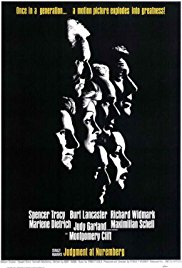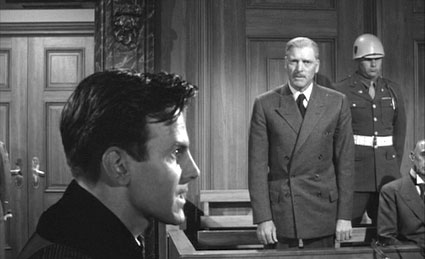JUSTICE AND HUMAN RIGHTS
1. What is a war crime?
2. What is a crime against humanity?
3. What are the Geneva Conventions?
4. What could an individual German have done to protest the conduct of the concentration camps? Suggested Response: See Learning Guide to “Schindler’s List” and Learning Guide to “The White Rose”.
5. What did you think of the German woman, Madame Bertholt, who befriended the Judge? What were her motives? Did you trust her? Compare Madame Bertholt to Emilie Schindler, Oscar Schindler’s wife, who was very much his partner in his heroic efforts and who explained her actions and those of her husband by saying, “We only did what we had to do.” See Learning Guide to “Schindler’s List“.
6. What did you think of Herr Rolfe, the defense lawyer? Did these men deserve a defense? Would you have defended them if you had been asked to do so?
7. What right did the Allies have to try Germans for war crimes when the Allies firebombed Dresden, Tokyo, and other cities and when the U.S. used the atomic bomb (see Learning Guide to “Fat Man & Little Boy”)?
8. Should the prosecutor have asked for lighter sentences because of fear of the reaction of the German people? At the time of the trials, the Cold War was just beginning. Should Judge Haywood have changed his verdict to keep West German support against the Russians?
9. Was the U.S. Army general correct when he told the prosecutor that “The thing to do is to survive, isn’t it? Survive as best we can, but survive.” What did the prosecutor mean when he responded “What was the war all about?”
11. What do you think of the fact that of the 99 Nuremberg defendants given prison terms, none remained in prison by 1961?
12. Did you think that the young man (Rudolph Peterson) should have been castrated? Should his mother have been allowed to have ten mentally defective children? If not, who should have decided how many children she should have had?
13. What were the differences between the German concentration camps and the camps in which the U.S. government interred Japanese-Americans? Were those differences sufficient to justify what the U.S. did to Japanese-Americans during the Second World War?
14. Many persons participated in the war crimes in Germany during the Second World War. The defendants shown in this film were surely not the worst war criminals in the country. Does this mean that they should have gone free? Judge Haywood, in responding to this argument made by Rolfe, the defense attorney, said, “If these murderers were monsters, this event would have no more moral significance than an earthquake.” Do you agree?
15. For centuries, judges enforced laws upholding slavery. For almost a hundred years, they upheld laws requiring segregation and prohibiting interracial marriages. The U.S. Supreme Court has upheld a law sterilizing mentally retarded individuals. In many states there are laws permitting pregnant girls under the age of 18, whose parents will not give consent to them having an abortion, to go to a judge and obtain permission to have the procedure. There are many who believe that the judges applying these laws have condoned crimes against humanity. Should these judges be tried under the Nuremberg principles?
MALE ROLE MODEL
16. Do you think that Judge Haywood was a male role model?





